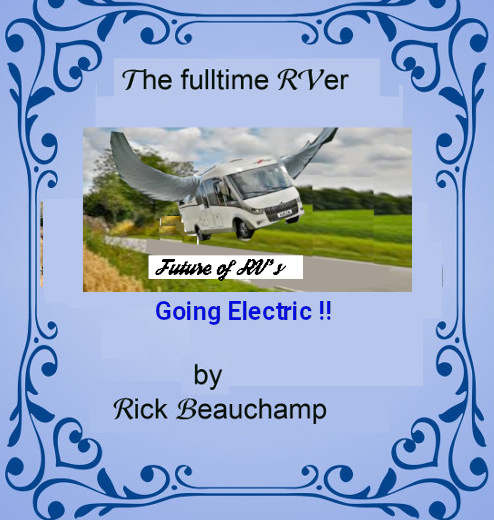

The
RV Lifestyle
Welcome to my review of the RV industry that is about to change
in a drastic but good way. As the USA and Canada move to meet
zero emissions by 2050 steps are being taken to end New
vehicle sales of gas and diesel units by 2030, Used vehicle sales
of
gas and diesel units by 2035 and an end to use of
ALL
gas
and diesel vehicles by 2040.
The RV industry will not be immune to these changes. I have noted that dropping sales and damages due to the Pandemic has resulted in many RV makers and RV sales outlets closing. How well the remaining RV makers or new players fair in the market may well be solely on their ability to adapt and address needs moving ahead. I found so far only two (Thor RV, and Winnebago RVs ) out of 12 still in business saying they are actively developing EV / EV-Hybrid models. There is just 16 years for the industry to figure things out or pass into oblivion. People have demonstrated their desire to have a recreational life after work or an RV lifestyle summed up this statement by an unknown author...
“Class A Motorhomes are the most luxurious of RV types. Available with a front-mounted gas or diesel powered engine, these motorized RVs the most powerful and largest RVs on the market. Typically fully-loaded with extras, these "homes away from home" are great for long trips, as well as full-time RVing! Price range for a brand new Class A is $60,000 to 950,000 or more.” |
I puzzle a bit over the common sense made by RV makers. In the past, RV motorhomes had a sloped front to improve gas mileage by cutting wind resistance, automakers also tried to keep profiles low and aero dynamic but over the last 20 years we have gone from sloped to flat. My 1994 motorhome got 10mpg with a sloped front and my 2007 new motorhome was tasked to get 4mpg and had a flat front. Even Transports use sloped front with rooftop sloped shields to cut wind resistance. See below…

Figure 1: 1994 motorhome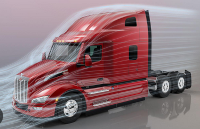
Figure 2 transport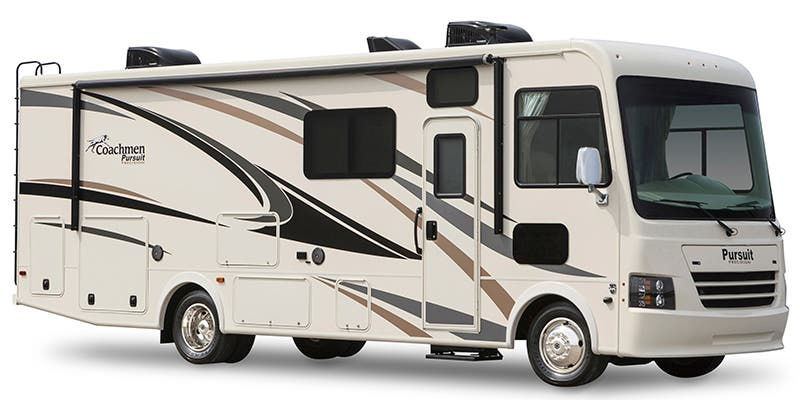
Figure 3: 2007 motorhome
You want better battery life on an EV and greater distance then lose the Flat front. All it is doing is dropping your range by simulating a weight gain of 4000 lbs so if maxed out GVWR is 24,000 lbs the flat front gives you GVWR 28,000 lbs as it pertains to wind resistance If you have 100KW of battery, 100/(28,000/10,000) = 35.71 miles range but with the sloped front is 100/(24,000/10,000)=41.67 miles .
Why do RV makers put gensets in RV’S that run on gas? Gas degrades with-in 6 months if not used but propane is good for 25 years. Gas hydrocarbons and monoxide is 65 x that of propane and the genset has no emission control system. Propane has less power output than gas but it does quite well. My mini-van on gas got 14mpg back in 2004, and once converted to propane got the equivalence of 13mpg with no appreciable drop in performance. Being that propane is far cleaner burning than gas the genset will last 10 x longer because the damage done by gas carbon deposits is avoided. Being an RV the genset takes on the role of being a back-up system just it is in home genset situations. The smarter move is to modify the genset with a regulator and aspirator and tie into the same LP gas system already present on the RV. As the industry moves to go green by 2040 there won’t be gasoline anyways but propane is not on the chopping block because of it’s clean burning nature.
While we are on the subject of propane vs gas, I do note that there is talk of using gas operated hybrid engines kinda like Chevy volt to augment electric range. This is the most backward idea in my humble opinion because availability of gas is disappearing by 2040. So the plan is to make an EV motorhome on battery and keep an 80 gal gas tank (480 lbs) and small engine (400 lbs) to supply an alternator developed energy source of about 1.5 KW - 0.1 KW loss in added weight. Using the previous figures 100/(24,000/10,000)=41.67 miles we now get 101.5/(25,020/10,000)=40.56 miles. That is no bargain but consider this. Gasoline has a weight of 6 lbs per gallon and propane is 4.2 lbs per gallon in liquid form. Enlarge the propane tank from say 25 gals to 50 gals running a modified 5000watt genset. You are adding 105 lbs using the same equipment that the RV has and getting 10A charge while you drive. The effect can be 100/(24,000/10,000)=41.67 miles becomes 105/(24,100/10,000)=43.16 miles. I can’t say what is going to happen to fuel pricing but back in 2004 I paid $0.21 per ltr for propane and $1.04 per ltr for gasoline. Gas is now $1.40 per ltr and propane afaict is $0.90 per ltr.
Here is my next observation, while reading through specs on motorhomes there is still talk of onboard propane/electric hot water tanks. These are most unsuitable for year round camping or Rving. Who really wants to heat water 24/7 at about $30/month and use that water for 2 or 3 x 10 minute showers spaced apart so the tank can reheat. You are adding 90 lbs for no great benefit. A 110v instant hot water can be placed in warm space at way less expense in cost and operation. I replaced my 10gal water tank ($689) with Instant hot water ($129) and immediately saw a $30/month decrease in propane use and saw a $0.01/month increase in metered electricity.
Later on I have included my review of the RV class A models and note there really isn’t anything special, jaw dropping, or amazing about the model appearances on the outside. With cars and trucks we had plain painted surfaces with fender wings or fancy shapes of the body to make one stand out over another and progressed to the woody look for wow effect. Then entered the two tone paint combo’s, and occasional pin striping but now you see one car or truck and it is the same as every other car or truck on the road unless you self customize. The motorhomes are just long square elongated blocks on wheels. These blocks each have the same overall appearance with no distinction other than the applied swirly waves.
 I have worked with the mobility impaired in the past and wonder why
these mobility challenged or those whom care for the mobility
challenged seem not to matter to the car, truck, trailer RV, or motor
RV industries.
Surely, wider entry doors and / or entry assist ramps or lifts can be made as
options or kits. Myself, I can no longer climb ladders to inspect the roof so my
answer was to construct an elevator on the back to assist me.
I have worked with the mobility impaired in the past and wonder why
these mobility challenged or those whom care for the mobility
challenged seem not to matter to the car, truck, trailer RV, or motor
RV industries.
Surely, wider entry doors and / or entry assist ramps or lifts can be made as
options or kits. Myself, I can no longer climb ladders to inspect the roof so my
answer was to construct an elevator on the back to assist me.
Simple platform with cable run hand crank with passive and active locks on dual tracks and rear guardrail with 700 lb weight capacity even though I am 200 lbs. It raises out of the way for pulling a toad vehicle.
So that is my look at the industry today and how I feel it should change going into the future. I am offering my insight in some smart EV concepts that might be a game changer going forward. My mom made one double barreled request of me before she passed. Part one was to convert my old motorhome into a fully electric RV. Part two was to pass on my knowledge to as many who would accept it before I pass.
To this end, I have designed two universal control systems. One can be used to convert any car or truck into an EV and the other is for Motorhomes. While a car or truck is generally being driven or parked for charging then left till next time it is needed, a Motorhome is driven, Parked for charging then used for living so it has two systems because we really don’t need drive systems on if we are just living in it.
 To the left we have 3 different touch screen sizes. Each is self contained with the same circuits but intendend for the different dash sizes found in vehicles.
To the left we have 3 different touch screen sizes. Each is self contained with the same circuits but intendend for the different dash sizes found in vehicles.
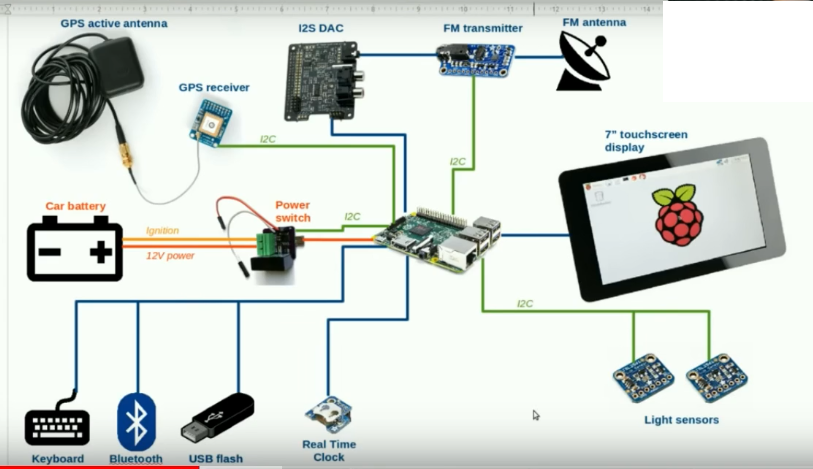
Missing from the left image is the optional built-in dashcam and rear view camera. The unit is self contained with built-in trouble shooting test functions that don’t require a special ODBC11 device to interpret error codes. Owners can check their own systems without spending $150 to find out what needs fixing.
A 12v tap on the Gcells supply the 12v systems
Next I developed a battery bank system for EV conversion of any vehicle including motorhomes. I totally buck the single large pack as a left over bad idea of the automotive industry. In the automotive industry we deal with one gas tank with in-tank pump and messy ignition control and timing. Electrics don’t have this constraint. An electric vehicle can have batteries anywhere appropriate. Instead of one large pack we can have 2 smaller packs called banks with the sum of banks = pack size. Further to this we break each bank down into user replaceable Gcells about the size of a lead acid but at the fraction of the weight. 85 lbs of lead acid at 12v becomes 34 lbs of lithium cells at 48v. 8 Gcells = one 384v bank at 42A for a pack size 384v @ 84A (small car) to 384v @ 288A for a motorhome. While your driving on one bank, you reach the end of it’s charge. The system switches to the second bank and places the first bank on charge from solar panels on the roof and/or genset (on propane). With battery Gcells of standard sizes 48v @ 42A, 48v @ 84A, 48v @ 144A we can have auto suppliers provide replacements just as they do for the current auto industry. A 12v battery has corrosive acid a rating of 65 to 110A and a CCA rating of 800 to 1500A and our Gcells are 48v @ 42A to 144A at 10”x 10”x 6” to 10”x30”x6”. Gcells would have a 12v tap, a 48v main and a Ground terminal.
The run vs charge uses a switch over unit using high power mosfets the Gcells run in series (384v) during drive mode and in parallel (48v) in charge mode. The charge system on cars and trucks run from the drive computer with shutdown when complete function. On a motorhome a separate coach controller takes over when the vehicle drive system shuts down. The coach system controls the charging by shore power, genset, solar, It can review or record video from dashcam, rear view camera, control lighting, heating, air conditioning and water supply (internal fresh tank, external campground) and of coarse instant hot water too.
One of my biggest nu-senses was having a 5’ tall mother with all the light switches at the 8’ ceiling. The coach control fixes that problem as well.
The solar array (15 roof top panels) provide 57v @ 15A to 30A solar charge depending on sunlight. The solar power can be engaged even when driving to recharge the dormant battery bank. Because the Gcells switch to parallel for charging, the charge time is 8 x longer than if a single Gcell is charged. The computer monitors charge and discharge by coulombs for the most accurate charge reading and positive control of the 20% lower and 90% upper limits on Gcells.
At one point I was planning an auto tilt for the solar array but cost, weight, and complexity ended that idea.
With all my planning I did build a solar electric custom tricycle frame with a 100 to 500 km range per charge. I hope to finish that as proof that my engineering is sound. Then I will do the actual motorhome and car builds. When the government made it’s announcement of the climate action plan ending all ICE vehicles by 2040 I knew I had to act. Yes I can build a solar electric Tricycle, maybe even convert a car and motorhome but what about the roughly 24.8 million registered vehicle users in Canada and 215 million++ users in the USA. This plan while good for the planet is going to be a double edge sword. Everyone has to lose their ICE based cars, trucks, and RV’s and replace them. Salvage lots will have an influx of 240 million vehicles in 16 years with no market for parts on hand, Just here in Canada if we can convert 24 million plus vehicles to EV it would take doing 21,160 vehicles a day for 16 years. We need conversion shops, motor suppliers, Gcell makers, Engine and Trany reclaimers, Solar cell makers, Control system suppliers and co-operation from the auto industry and that includes the RV industry. If the RV industry is to survive it has to not only develop and sell new EV-RV’s but it’s sale lots are certainly not going to accept RV trade-ins if their only coarse of action is to junk them. Few people will choose to lose a vehicle that cost them the price of a small cottage or a city house and buy new.
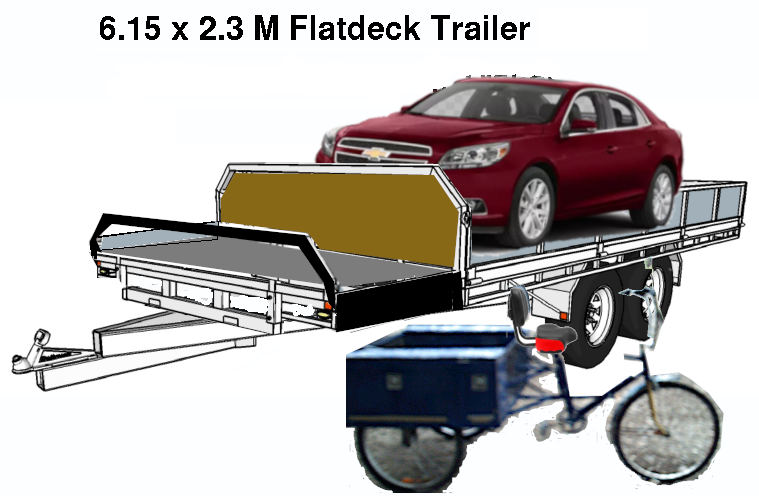
Idle hands! What can I say. If I am going have a solar electric RV, a solar electric tricycle for short travels, and a solar electric car surely I need a fancy trailer to take them with me.
Now as promised the RV market new and used models at risk of becoming obsolete over the next 16 years. What follows is every known North American model with new models in bold. I don’t concern myself with interiors although I do list number of floor plans. My 30 year old fully paid for model that has been my year round home is proof of my commitment to the lifestyle. My only wish is that my unit didn’t have those nasty lift up bin doors that sometimes drop on my head due to weak gas struts. A side open door would be nicer.
I do have my full EV conversion plans available for the EV-Tricycle, EV-Mini-van, EV-Pick-up Trucks and of course the EV-Motorhome for someone that wants to embark on doing EV conversions and build on what I have designed.
Check-out www.werunique.us

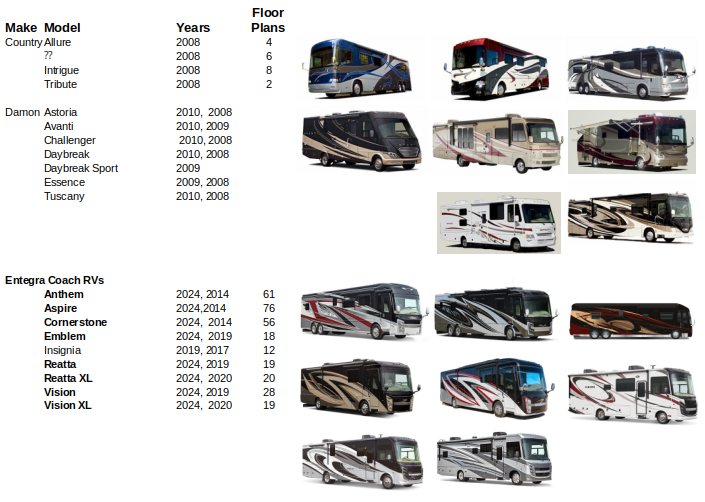
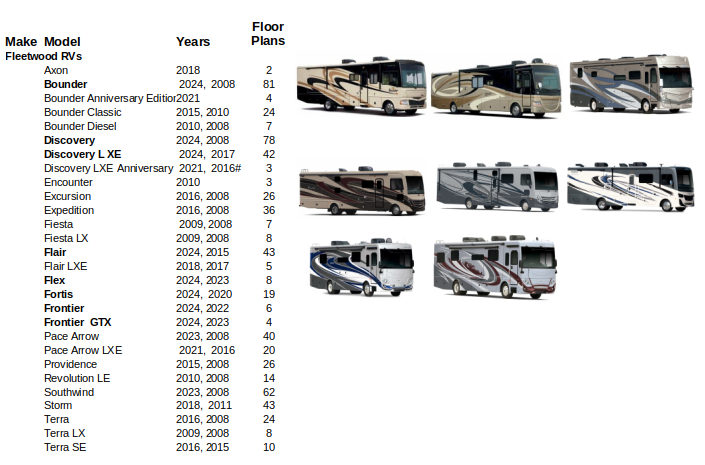
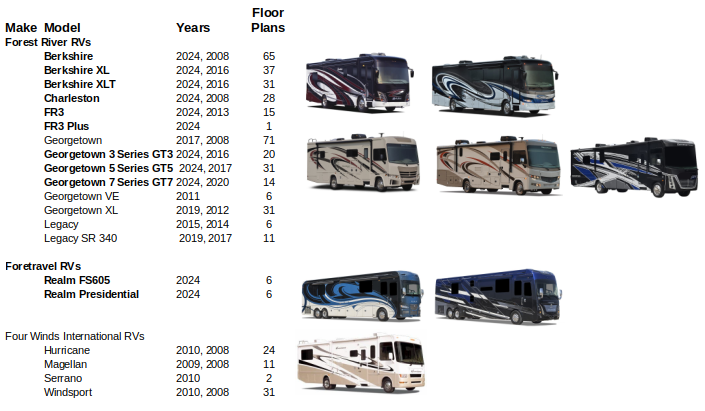
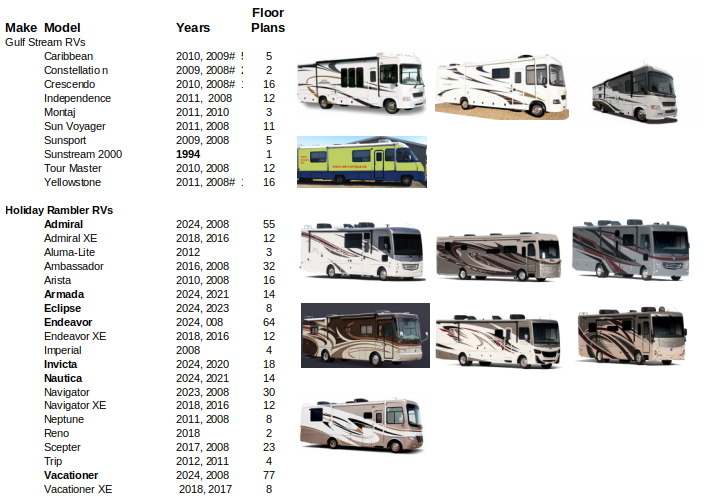
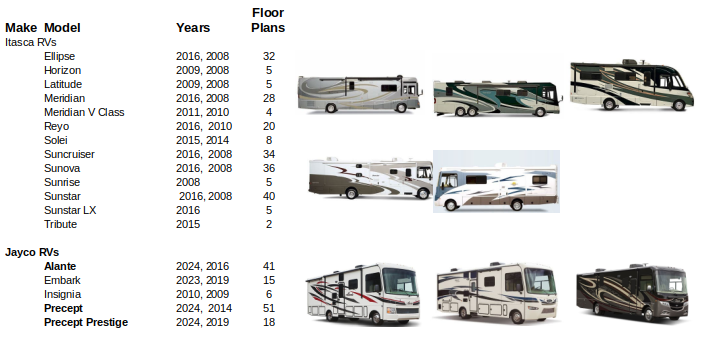
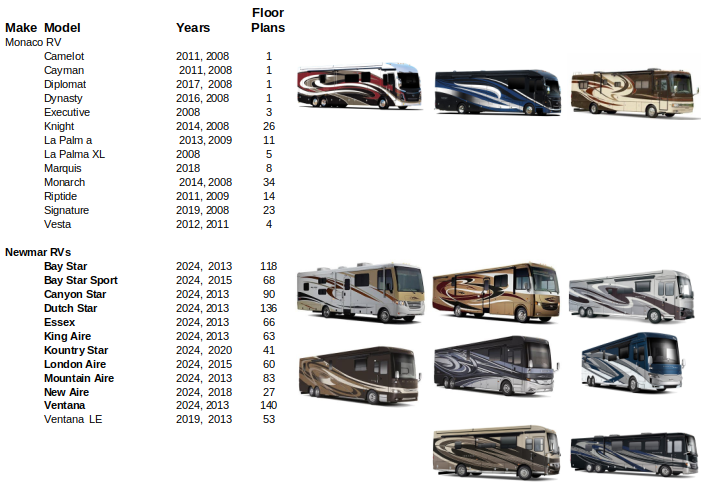
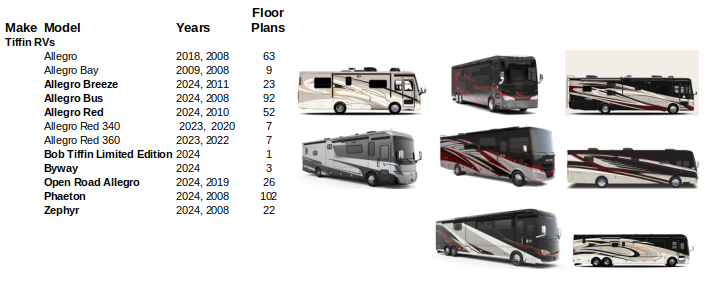

I take it from the information listings that models before 2000 don’t rank as in use any more. This concludes my report on the future of the RV industry as it pertains to Class A motorhomes. Thank you for reading hope you appreciate my thoughts as a grumpy old man.
![]()